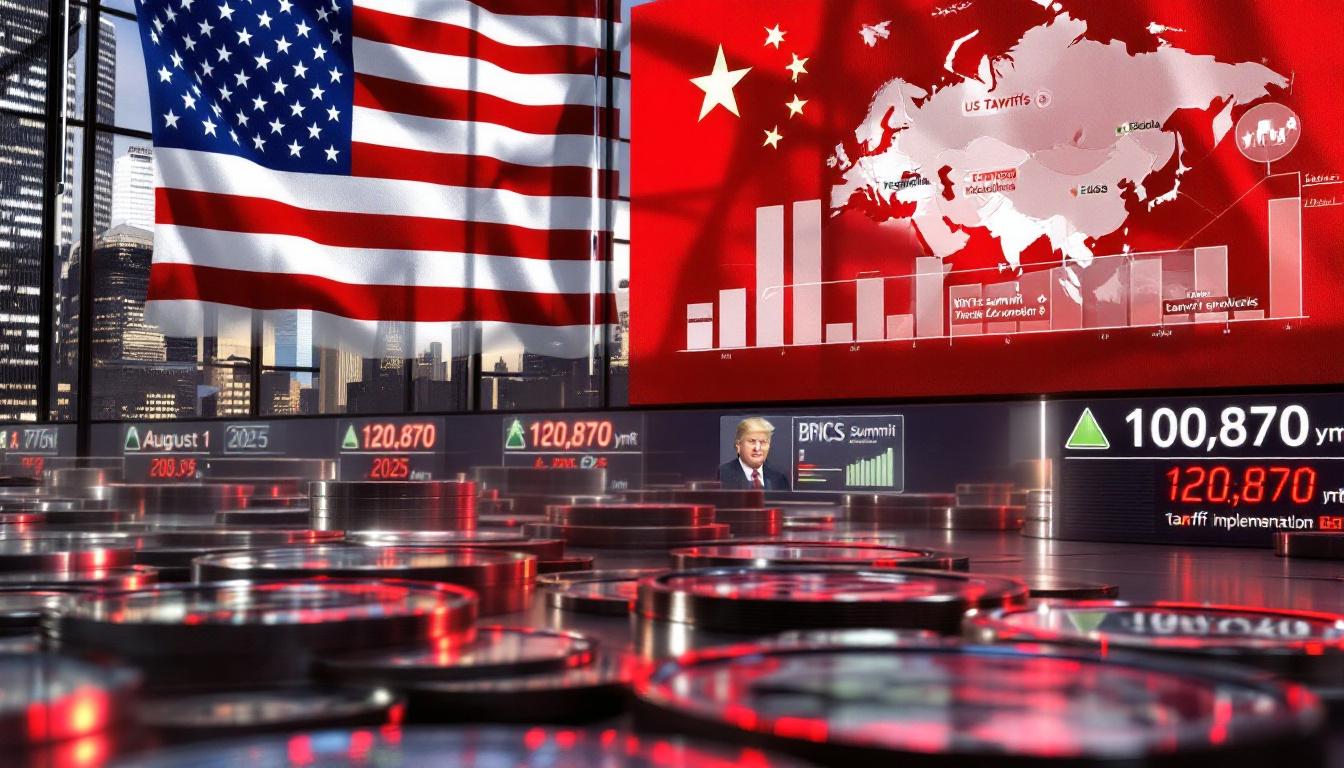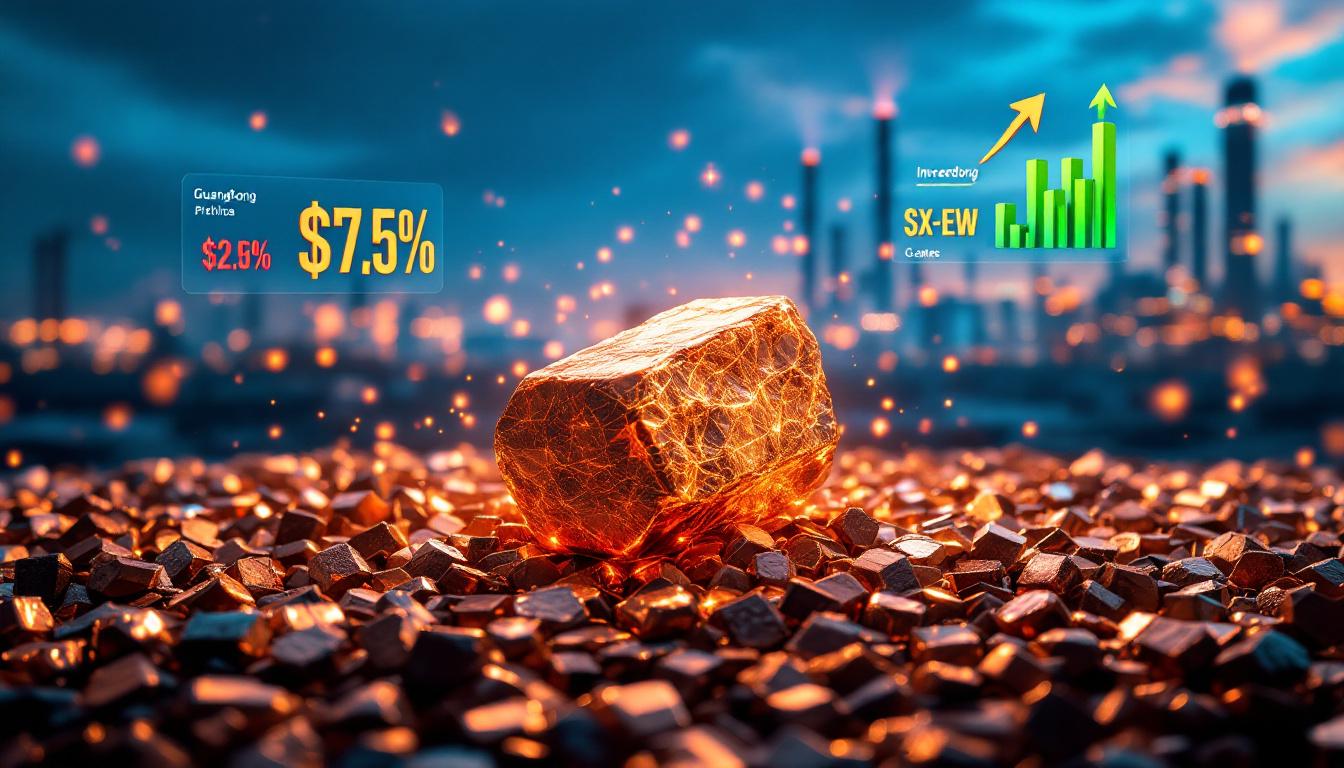What Are the Latest Trends in Base Metal Prices?
The SMM metal spot prices on July 7 revealed significant movements across various base metals, with copper, zinc, and tin markets showing distinct patterns influenced by downstream demand, regional variations, and macroeconomic factors. These daily price fluctuations offer valuable insights for traders and industry participants monitoring market dynamics.
Copper Market Performance
Copper prices continued their downward trajectory on July 7, with sustained weakness in spot premiums and discounts across major trading hubs. The primary driver behind this decline has been widespread reluctance from downstream buyers to replenish inventory, creating persistent pressure on spot prices despite periodic technical rebounds.
Regional variations have become increasingly pronounced between North and South China copper markets. While North China premiums weakened steadily despite copper price pullbacks, South China markets exhibited greater intraday volatility with session-specific fluctuations marking trading patterns throughout the day.
The Guangdong spot copper market demonstrated notable session-by-session premium/discount fluctuations, with fourth-session data recorded at 10:45 AM showing particularly significant movements. Market participants reported thin transactions during early sessions followed by moderate improvements later in the day as some buyers emerged at lower price points.
"Regional premium divergence between Guangdong and Shanghai markets has widened to multi-week highs, indicating localized supply-demand imbalances despite uniform pricing pressure nationwide," noted SMM's regional copper analyst.
Shanghai spot copper transactions similarly experienced notable fourth-session movements, though with distinctive patterns compared to Guangdong. Trading volumes remained constrained throughout most sessions, with sporadic buying interest emerging primarily from traders rather than end-users, suggesting continued caution regarding near-term price direction.
Zinc Market Developments
The zinc market demonstrated improved transaction volumes on July 7, primarily driven by opportunistic downstream purchasing at lower price points. This price sensitivity highlights the current market dynamic where buyers remain hesitant to commit at higher levels but actively engage when prices retreat to perceived value zones.
The Shanghai zinc market witnessed increased activity compared to previous sessions, with spot premiums adjusting to accommodate the uptick in buying interest. This improved liquidity came predominantly from smaller downstream fabricators seeking to fulfill immediate production needs rather than building strategic inventory positions.
In contrast, the Ningbo zinc market featured more active trader participation with relatively stable premium changes despite broader market fluctuations. This stability in premium structures despite price volatility suggests stronger trading fundamentals in this regional market compared to other hubs.
- Traders actively quoted throughout all sessions in Ningbo
- Downstream buying concentrated in early sessions in Shanghai
- Premium stability in Ningbo contrasted with Shanghai's more volatile patterns
- Regional arbitrage opportunities emerged but remained limited by transportation costs
Market observers noted that the divergent regional patterns in zinc trading reflected not only local supply-demand balances but also varying expectations regarding short-term price direction among different market participants.
Tin Market Analysis
SHFE tin faced significant downward pressure amid heightened market volatility on July 7, with prices testing technical support levels throughout the session. The confluence of weak domestic demand and uncertain macroeconomic indicators contributed to cautious sentiment among market participants.
LME tin prices continued to await breakthrough developments in macroeconomic indicators, with traders closely monitoring global manufacturing data and central bank communications for directional cues. This macro-dependency has created a holding pattern where significant price movements remain constrained pending clearer economic signals.
Technical analysis suggests potential directional shifts based on well-established support and resistance levels. Current price action indicates consolidation within a narrowing range, typically a precursor to a more decisive price movement once key technical thresholds are breached.
Industry observers remain particularly focused on semiconductor and electronics manufacturing forecasts, as these sectors represent approximately 50% of global tin consumption. Recent mixed signals from these industries have contributed to market uncertainty and limited directional conviction among traders.
How Are Precious and Minor Metals Performing?
While the July 7 SMM report focused primarily on base metals, the precious and minor metals markets continue to exhibit distinctive patterns influenced by unique supply-demand dynamics and specialized industrial applications.
Rare Earth Elements Market Update
The rare earth elements market has demonstrated remarkable resilience despite broader metal market volatility. Praseodymium-neodymium oxide, a key material for permanent magnets used in electric vehicles and wind turbines, has maintained stable pricing levels supported by consistent demand from the renewable energy sector.
Heavy rare earth elements, including dysprosium and terbium, have shown greater price stability compared to light rare earths, reflecting their more constrained supply characteristics and critical applications in high-performance magnets and defense technologies.
Supply-demand dynamics continue to evolve as China's enhanced environmental regulations impact domestic production while international projects progress toward commercial viability. This shifting landscape has created price divergence between domestic Chinese markets and international rare earth benchmarks.
"The rare earth market's relative stability amid broader commodity volatility highlights its increasingly disconnected fundamentals from traditional industrial metals cycles," notes a senior industry analyst.
Recent developments in battery recycling developments have begun to influence market sentiment, though their immediate price impact remains limited compared to primary production dynamics and export policy considerations.
Precious Metals Price Movements
Precious metals have demonstrated characteristic haven-asset behavior amid recent economic uncertainty, with gold maintaining its traditional role as a monetary alternative during periods of inflation concern and currency volatility.
Silver has exhibited its typical hybrid behavior, responding both to industrial demand factors and investment flows. This dual nature has created more pronounced price volatility compared to gold, particularly as electronics manufacturing forecasts have shifted throughout the quarter.
Platinum group metals continue to face pressure from automotive sector transitions, with palladium particularly vulnerable to reduced catalyst demand as electric vehicle adoption accelerates. However, industrial applications beyond automotive continue to provide meaningful support, especially for platinum in chemical catalysis and hydrogen applications.
Minor Metals Market Snapshot
Silicon metal prices have remained under pressure from weak solar sector demand and increased production capacity, creating challenging conditions for higher-cost producers. The metal's critical role in aluminum alloys, silicones, and semiconductors continues to provide baseline support despite oversupply concerns.
Magnesium markets have stabilized following earlier supply disruptions, with prices trending toward long-term averages as production normalizes. The metal's lightweight structural applications in automotive and aerospace continue to underpin demand fundamentals despite near-term growth concerns.
Titanium markets reflect divergent trends between aerospace-grade material and commercial-grade products, with premium aerospace specifications maintaining stronger pricing amid renewed commercial aircraft production increases. The metal's corrosion resistance and strength-to-weight characteristics continue to support its critical industrial applications.
What's Happening in the Steel and Ferrous Markets?
Steel Market Morning Analysis
Steel futures and spot prices demonstrated rangebound fluctuations on July 7, with particularly weak hot-rolled coil (HRC) trading performance throughout the day. Market participants reported average overall trading conditions, with limited price movement despite periodic attempts to establish directional momentum.
The HRC market serves as a bellwether for broader steel sentiment, and its lackluster performance on July 7 reflected persistent concerns regarding near-term demand outlook and production discipline among major mills. Spot transactions remained concentrated in essential restocking rather than speculative positions.
A significant development affecting market liquidity was the completion of a ¥520 billion yuan fixed increase fundraising initiative from four major Chinese banks. This substantial capital infusion has potential implications for industrial financing and infrastructure project funding, though its immediate price impact remains limited pending deployment details.
"The banking sector's substantial fundraising suggests potential improvements in industrial financing availability, though steel demand ultimately depends on project implementation timelines rather than mere capital availability," observed a market analyst.
Regulatory factors continue to influence market dynamics, with a gradual and orderly approach to cultivated land restoration emerging as a consideration for construction-related steel demand. This measured policy implementation approach has prevented more disruptive demand impacts while maintaining environmental priorities.
Iron Ore and Raw Materials Outlook
Raw material markets for steelmaking continue to exhibit complex supply-demand interactions, with iron ore trends influenced by both seaborne supply dynamics and Chinese domestic production levels. Australian and Brazilian shipments remain the primary determinants of import pricing, while domestic concentrate production responds to margin considerations.
Coking coal markets demonstrate regional variations between domestic Chinese production and imported materials, with quality differentials playing an increasingly important role in price determination. The spread between premium hard coking coal and secondary grades has widened as mills prioritize efficiency and emissions considerations.
Production cost structures continue to influence pig iron pricing, with energy costs and environmental compliance expenses becoming more significant components of the overall cost stack. This evolving cost structure has implications for steel mill margin management and pricing strategies across the value chain.
How Is the New Energy Metals Sector Performing?
Lithium Market Insights
Significant concerns regarding lithium price sustainability emerged on July 7, with major industry player Ganfeng Lithium stating that "current lithium prices may not be sustainable" and that "costs of multiple projects are hard to support" at prevailing market levels. This rare public assessment from a leading producer signals potential structural challenges in the lithium supply pipeline.
Project viability concerns center around the capital-intensive nature of new lithium developments, particularly hard-rock mining operations that require substantial upfront investment before reaching commercial production. The current pricing environment creates challenging economics for projects in the development pipeline.
Supply-demand balance perspectives vary significantly among market participants, with some forecasting continued oversupply through 2025 while others anticipate potential supply constraints as project delays accumulate and demand growth from electric vehicle production accelerates beyond conservative estimates.
"The lithium industry faces a classic resource investment dilemma – prices need to be high enough to incentivize new production but low enough to support demand growth from price-sensitive applications," explains an industry consultant.
Market observers are closely monitoring inventory levels throughout the battery supply chain as a leading indicator of potential price direction changes. The accumulation or depletion of material at various stages from mine to cathode production provides valuable insights regarding real-time supply-demand balances amid ongoing lithium market challenges.
Battery Materials Supply Chain
The broader battery materials sector continues to evolve rapidly, with cathode, anode, separator, and electrolyte materials each demonstrating unique pricing dynamics based on specific technological and supply factors. The interconnected nature of these markets creates complex feedback mechanisms throughout the battery production chain.
Cathode material pricing reflects both underlying metal costs (lithium, nickel, cobalt, manganese) and processing premiums, with chemistry-specific trends emerging as automotive manufacturers commit to particular battery technologies. The ongoing shift toward higher nickel content in NMC formulations continues to influence relative pricing among cathode variants.
Anode materials markets center predominantly around natural and synthetic graphite pricing, with silicon-enhanced materials gaining market share in premium applications. Processing capacity, particularly spherical graphite production, remains a key determinant of pricing power within the supply chain.
Battery recycling continues to gain commercial traction, with used lithium-ion battery collection rates and processing technologies improving steadily. While still representing a small fraction of overall material supply, recycling increasingly influences long-term supply forecasts and sustainability considerations.
The emerging sodium-ion battery technology sector has begun to create modest disruption in traditional lithium battery markets, particularly for stationary storage and cost-sensitive applications. This technology's commercial scaling creates both opportunities and challenges for established lithium-ion supply chains.
What Are the Global Factors Influencing Metal Markets?
Geopolitical Considerations
A significant geopolitical risk factor emerged in recent analysis regarding potential Strait of Hormuz disruptions on aluminum markets. The SMM analysis published on July 7 examined how a theoretical blockade of this critical shipping chokepoint could severely impact global aluminum flows, particularly from Middle Eastern producers.
The Strait of Hormuz handles approximately 20% of global aluminum shipments, with major producers like Emirates Global Aluminium (EGA) dependent on this maritime route for exports. Any disruption would necessitate costly and time-consuming rerouting, potentially creating regional supply shortages and price premiums.
Regional trade policy impacts continue to evolve, with particular attention to export restrictions, tariffs, and environmental standards affecting metal flows between major producing and consuming regions. These policy developments create both challenges and opportunities for market participants navigating an increasingly complex regulatory landscape.
"The increasing frequency of trade policy interventions in metals markets reflects both economic security considerations and environmental standards harmonization efforts," notes a trade policy expert.
International regulatory developments regarding carbon intensity and sustainability metrics have begun influencing pricing structures beyond simple compliance costs. Premium markets for low-carbon metals continue to develop, particularly in aluminum and steel, creating new differentiation opportunities within previously commoditized markets.
Industry Expert Perspectives
The recently concluded Indonesia Critical Minerals Conference & Expo 2025 brought together industry experts from 55 nations to discuss the country's growing role in global metals supply chains. The event highlighted Indonesia's strategic positioning in nickel, copper, and other critical minerals essential for energy transition technologies.
Key takeaways from the Nickel & Cobalt Forum included perspectives on Indonesia's rapid expansion of processing capacity and the implications for global market balances. Industry participants debated the sustainability of current growth rates and the potential for overcapacity in certain processing segments.
Expert opinions on market direction and sustainability emphasized the increasing divergence between traditional industrial metal cycles and new energy materials. This uncoupling creates both challenges for forecasting and opportunities for specialized investment strategies focused on specific metal subsectors.
FAQ: Metal Markets and Pricing
How do regional differences affect metal pricing?
Regional variations in metal pricing stem from local supply-demand dynamics, transportation costs, warehouse availability, and regulatory environments. Markets like Shanghai and Guangdong often show different premium/discount patterns based on these factors. The July 7 SMM data highlighted this phenomenon in copper markets, where North China premiums weakened more significantly than South China, creating arbitrage opportunities for traders able to manage logistics efficiently.
What factors are currently influencing copper prices?
Copper prices are currently affected by downstream purchasing reluctance, inventory levels, global economic indicators, and regional demand variations between North and South China markets. The July 7 SMM report specifically identified "downstream reluctance to replenish inventory" as the primary driver behind recent price weakness, suggesting demand concerns rather than supply disruptions are setting the current market tone. For more detailed copper price insights, analysts recommend monitoring both macroeconomic indicators and regional trading patterns.
How can investors track historical metal price trends?
Investors can access comprehensive historical price data through specialized metal market information services like SMM, subscription-based platforms, and industry publications that track daily, weekly, and monthly price movements. SMM's price center (www.metal.com) provides historical data across multiple metals, allowing for trend analysis and pattern recognition. Additionally, futures exchanges like SHFE and LME offer historical contract pricing that can complement spot market data.
What is the relationship between futures and spot prices in metal markets?
Futures prices reflect market expectations for future delivery, while spot prices represent immediate physical delivery transactions. The relationship between these prices (contango or backwardation) provides insights into market sentiment and expected supply-demand balance. The July 7 steel market showed futures and spot prices fluctuating within a range, indicating balanced expectations without strong directional conviction from market participants.
How do macroeconomic factors impact metal pricing?
Interest rates, currency valuations, inflation expectations, manufacturing indices, and global growth forecasts all significantly influence metal pricing by affecting investment flows, industrial demand, and production costs. The July 7 tin market analysis specifically noted that LME tin prices were awaiting "macro breakthroughs" for directional cues, highlighting the market's dependency on broader economic indicators during periods of uncertainty.
Key Market Indicators to Watch
Price Support and Resistance Levels
Technical analysis of current price trends reveals significant support and resistance levels across major metals. For copper, the psychological price thresholds continue to function as important technical references, with round-number levels attracting increased trading activity and often defining short-term price ranges.
Zinc's technical picture shows well-defined support from production cost thresholds, with many marginal producers facing negative margins at recent price levels. This cost-driven support often creates natural price floors during market downturns as higher-cost production exits the market.
Potential breakout or breakdown scenarios remain closely tied to broader economic data releases and central bank communications. Technical traders are monitoring momentum indicators and moving average convergence/divergence patterns for early signals of potential trend changes across the metals complex.
Supply-Demand Balance Shifts
Production capacity changes affecting market equilibrium continue across multiple metals, with particular focus on Indonesian nickel expansion, Chinese aluminum capacity constraints, and Chilean copper production challenges. These supply-side developments interact with evolving demand patterns to create metal-specific market balances.
Consumption pattern shifts in key industries, particularly automotive, construction, and electronics manufacturing, drive demand-side market dynamics. The ongoing energy transition creates both opportunities and challenges for different metals, with copper and aluminum benefiting from electrification while traditional automotive-focused metals face changing demand patterns.
Inventory level impacts on price volatility remain a critical consideration, with low visible inventories creating the potential for heightened price volatility during supply disruptions or demand surges. Current inventory levels across several base metals remain below historical averages, creating structural support for prices despite near-term demand concerns.
Regulatory and Policy Developments
Environmental regulations affecting production costs continue to evolve globally, with carbon pricing mechanisms, emissions standards, and water usage restrictions creating differential impacts across producing regions. These regulatory frameworks increasingly influence competitiveness and investment decisions throughout the metals industry.
Trade policies influencing international metal flows have become more prevalent, with resource nationalism, strategic stockpiling initiatives, and export restrictions creating new market dynamics beyond traditional supply-demand considerations. Market participants must increasingly incorporate policy risk assessment into strategic planning.
Government initiatives impacting market dynamics include infrastructure spending programs, strategic reserves management, and industrial policy frameworks supporting specific manufacturing sectors. The July 7 report on the ¥520 billion
Ready to Identify Early-Stage Mineral Discoveries?
Discover significant ASX mineral discoveries before the broader market with Discovery Alert's proprietary Discovery IQ model, delivering real-time notifications that transform complex data into actionable insights. Explore why major mineral discoveries can generate substantial returns by visiting Discovery Alert's dedicated discoveries page and position yourself ahead of the market.




